Leadership Styles: Transactional and Transformational Analysis Report
VerifiedAdded on 2023/04/20
|11
|3391
|119
Report
AI Summary
This report provides a comparative analysis of transactional and transformational leadership styles within the context of organizational behaviour. It begins by defining and differentiating between the two styles, highlighting the transactional approach's focus on supervision, rewards, and short-term goals, exemplified by figures like Ma Yun. Conversely, it explores transformational leadership, emphasizing inspiration, individual development, and long-term outcomes, using Steve Jobs as an example. The report argues for the superiority of transformational leadership, citing factors like moral values, enthusiasm, self-motivation, and adaptability to turbulent environments. It contrasts the reactive nature of transactional leadership with the proactive approach of transformational leadership, emphasizing the latter's ability to foster innovation and long-term success. The report concludes by reiterating the benefits of transformational leadership in fostering a dynamic and adaptable organizational culture, making it more suitable for achieving extraordinary outcomes.

Organizational Behaviour
Paraphrase This Document
Need a fresh take? Get an instant paraphrase of this document with our AI Paraphraser
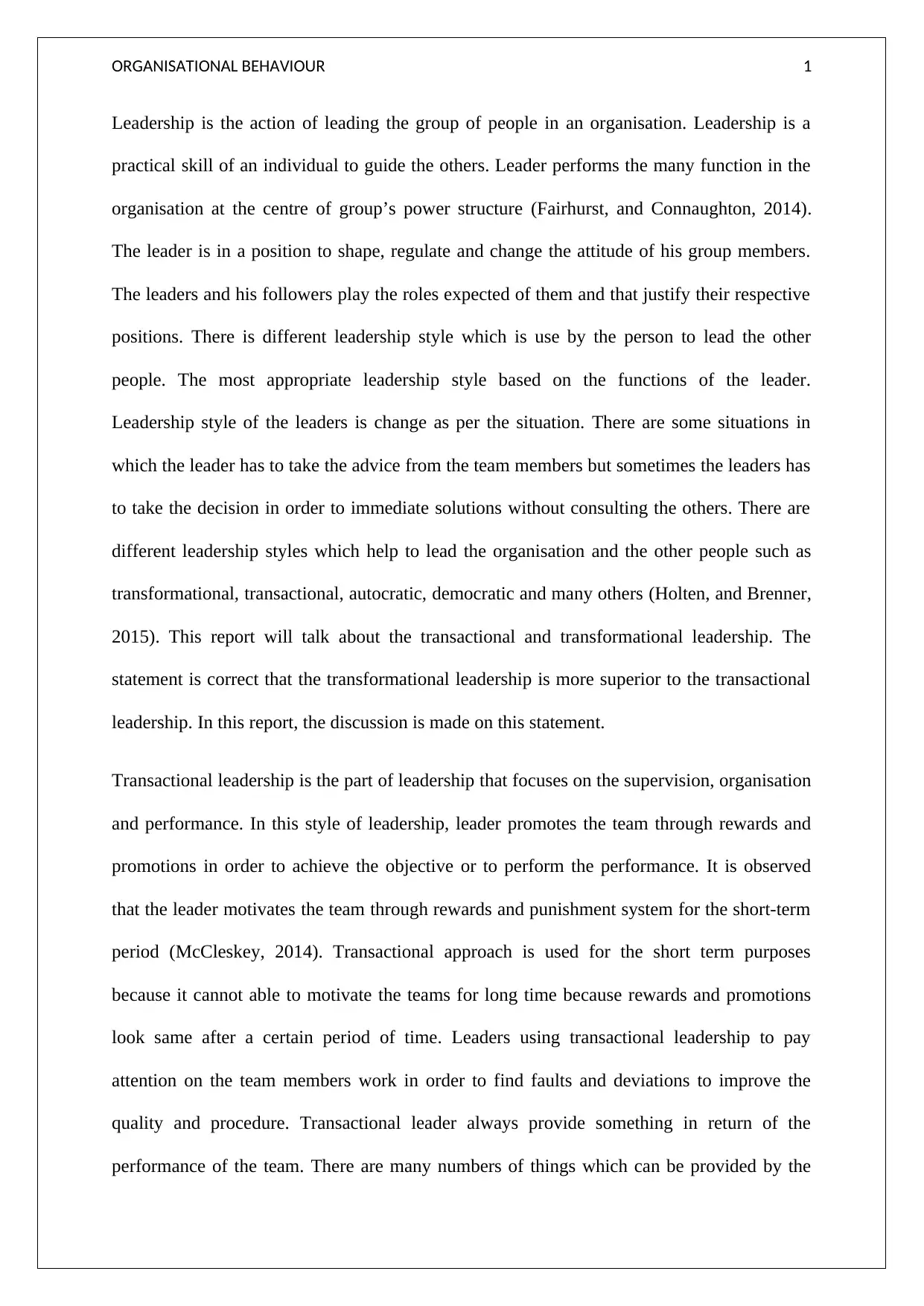
ORGANISATIONAL BEHAVIOUR 1
Leadership is the action of leading the group of people in an organisation. Leadership is a
practical skill of an individual to guide the others. Leader performs the many function in the
organisation at the centre of group’s power structure (Fairhurst, and Connaughton, 2014).
The leader is in a position to shape, regulate and change the attitude of his group members.
The leaders and his followers play the roles expected of them and that justify their respective
positions. There is different leadership style which is use by the person to lead the other
people. The most appropriate leadership style based on the functions of the leader.
Leadership style of the leaders is change as per the situation. There are some situations in
which the leader has to take the advice from the team members but sometimes the leaders has
to take the decision in order to immediate solutions without consulting the others. There are
different leadership styles which help to lead the organisation and the other people such as
transformational, transactional, autocratic, democratic and many others (Holten, and Brenner,
2015). This report will talk about the transactional and transformational leadership. The
statement is correct that the transformational leadership is more superior to the transactional
leadership. In this report, the discussion is made on this statement.
Transactional leadership is the part of leadership that focuses on the supervision, organisation
and performance. In this style of leadership, leader promotes the team through rewards and
promotions in order to achieve the objective or to perform the performance. It is observed
that the leader motivates the team through rewards and punishment system for the short-term
period (McCleskey, 2014). Transactional approach is used for the short term purposes
because it cannot able to motivate the teams for long time because rewards and promotions
look same after a certain period of time. Leaders using transactional leadership to pay
attention on the team members work in order to find faults and deviations to improve the
quality and procedure. Transactional leader always provide something in return of the
performance of the team. There are many numbers of things which can be provided by the
Leadership is the action of leading the group of people in an organisation. Leadership is a
practical skill of an individual to guide the others. Leader performs the many function in the
organisation at the centre of group’s power structure (Fairhurst, and Connaughton, 2014).
The leader is in a position to shape, regulate and change the attitude of his group members.
The leaders and his followers play the roles expected of them and that justify their respective
positions. There is different leadership style which is use by the person to lead the other
people. The most appropriate leadership style based on the functions of the leader.
Leadership style of the leaders is change as per the situation. There are some situations in
which the leader has to take the advice from the team members but sometimes the leaders has
to take the decision in order to immediate solutions without consulting the others. There are
different leadership styles which help to lead the organisation and the other people such as
transformational, transactional, autocratic, democratic and many others (Holten, and Brenner,
2015). This report will talk about the transactional and transformational leadership. The
statement is correct that the transformational leadership is more superior to the transactional
leadership. In this report, the discussion is made on this statement.
Transactional leadership is the part of leadership that focuses on the supervision, organisation
and performance. In this style of leadership, leader promotes the team through rewards and
promotions in order to achieve the objective or to perform the performance. It is observed
that the leader motivates the team through rewards and punishment system for the short-term
period (McCleskey, 2014). Transactional approach is used for the short term purposes
because it cannot able to motivate the teams for long time because rewards and promotions
look same after a certain period of time. Leaders using transactional leadership to pay
attention on the team members work in order to find faults and deviations to improve the
quality and procedure. Transactional leader always provide something in return of the
performance of the team. There are many numbers of things which can be provided by the
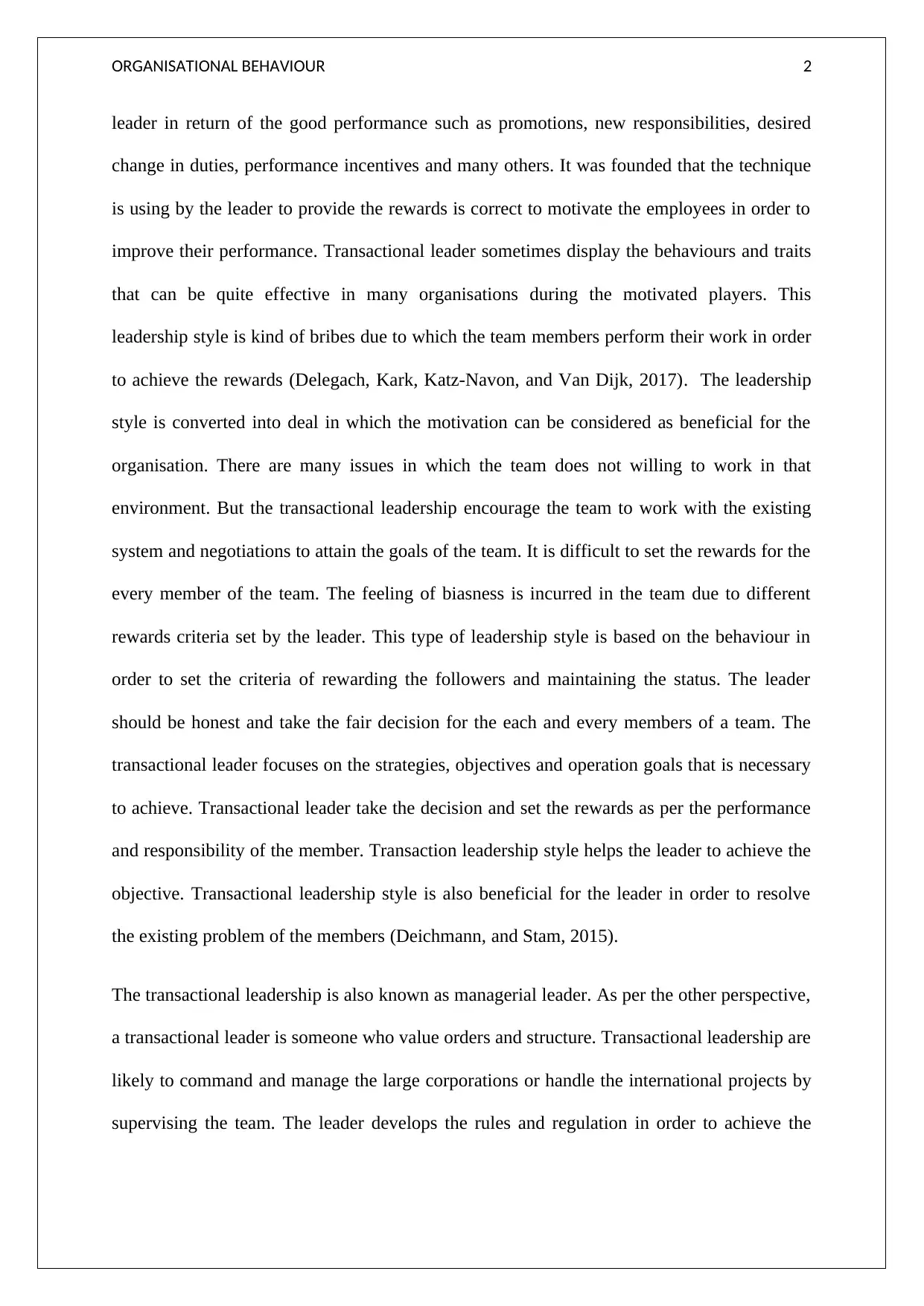
ORGANISATIONAL BEHAVIOUR 2
leader in return of the good performance such as promotions, new responsibilities, desired
change in duties, performance incentives and many others. It was founded that the technique
is using by the leader to provide the rewards is correct to motivate the employees in order to
improve their performance. Transactional leader sometimes display the behaviours and traits
that can be quite effective in many organisations during the motivated players. This
leadership style is kind of bribes due to which the team members perform their work in order
to achieve the rewards (Delegach, Kark, Katz-Navon, and Van Dijk, 2017). The leadership
style is converted into deal in which the motivation can be considered as beneficial for the
organisation. There are many issues in which the team does not willing to work in that
environment. But the transactional leadership encourage the team to work with the existing
system and negotiations to attain the goals of the team. It is difficult to set the rewards for the
every member of the team. The feeling of biasness is incurred in the team due to different
rewards criteria set by the leader. This type of leadership style is based on the behaviour in
order to set the criteria of rewarding the followers and maintaining the status. The leader
should be honest and take the fair decision for the each and every members of a team. The
transactional leader focuses on the strategies, objectives and operation goals that is necessary
to achieve. Transactional leader take the decision and set the rewards as per the performance
and responsibility of the member. Transaction leadership style helps the leader to achieve the
objective. Transactional leadership style is also beneficial for the leader in order to resolve
the existing problem of the members (Deichmann, and Stam, 2015).
The transactional leadership is also known as managerial leader. As per the other perspective,
a transactional leader is someone who value orders and structure. Transactional leadership are
likely to command and manage the large corporations or handle the international projects by
supervising the team. The leader develops the rules and regulation in order to achieve the
leader in return of the good performance such as promotions, new responsibilities, desired
change in duties, performance incentives and many others. It was founded that the technique
is using by the leader to provide the rewards is correct to motivate the employees in order to
improve their performance. Transactional leader sometimes display the behaviours and traits
that can be quite effective in many organisations during the motivated players. This
leadership style is kind of bribes due to which the team members perform their work in order
to achieve the rewards (Delegach, Kark, Katz-Navon, and Van Dijk, 2017). The leadership
style is converted into deal in which the motivation can be considered as beneficial for the
organisation. There are many issues in which the team does not willing to work in that
environment. But the transactional leadership encourage the team to work with the existing
system and negotiations to attain the goals of the team. It is difficult to set the rewards for the
every member of the team. The feeling of biasness is incurred in the team due to different
rewards criteria set by the leader. This type of leadership style is based on the behaviour in
order to set the criteria of rewarding the followers and maintaining the status. The leader
should be honest and take the fair decision for the each and every members of a team. The
transactional leader focuses on the strategies, objectives and operation goals that is necessary
to achieve. Transactional leader take the decision and set the rewards as per the performance
and responsibility of the member. Transaction leadership style helps the leader to achieve the
objective. Transactional leadership style is also beneficial for the leader in order to resolve
the existing problem of the members (Deichmann, and Stam, 2015).
The transactional leadership is also known as managerial leader. As per the other perspective,
a transactional leader is someone who value orders and structure. Transactional leadership are
likely to command and manage the large corporations or handle the international projects by
supervising the team. The leader develops the rules and regulation in order to achieve the
⊘ This is a preview!⊘
Do you want full access?
Subscribe today to unlock all pages.

Trusted by 1+ million students worldwide
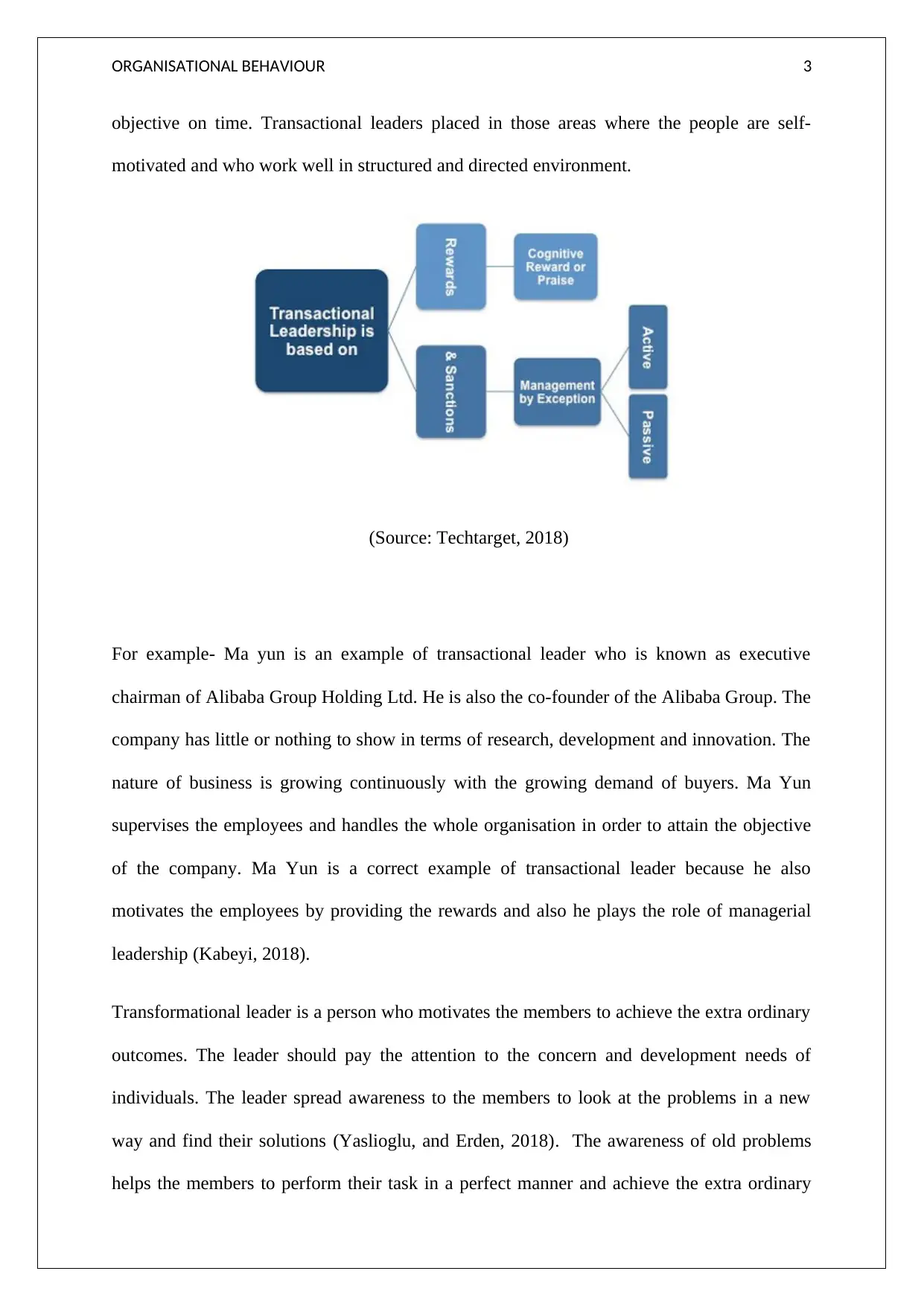
ORGANISATIONAL BEHAVIOUR 3
objective on time. Transactional leaders placed in those areas where the people are self-
motivated and who work well in structured and directed environment.
(Source: Techtarget, 2018)
For example- Ma yun is an example of transactional leader who is known as executive
chairman of Alibaba Group Holding Ltd. He is also the co-founder of the Alibaba Group. The
company has little or nothing to show in terms of research, development and innovation. The
nature of business is growing continuously with the growing demand of buyers. Ma Yun
supervises the employees and handles the whole organisation in order to attain the objective
of the company. Ma Yun is a correct example of transactional leader because he also
motivates the employees by providing the rewards and also he plays the role of managerial
leadership (Kabeyi, 2018).
Transformational leader is a person who motivates the members to achieve the extra ordinary
outcomes. The leader should pay the attention to the concern and development needs of
individuals. The leader spread awareness to the members to look at the problems in a new
way and find their solutions (Yaslioglu, and Erden, 2018). The awareness of old problems
helps the members to perform their task in a perfect manner and achieve the extra ordinary
objective on time. Transactional leaders placed in those areas where the people are self-
motivated and who work well in structured and directed environment.
(Source: Techtarget, 2018)
For example- Ma yun is an example of transactional leader who is known as executive
chairman of Alibaba Group Holding Ltd. He is also the co-founder of the Alibaba Group. The
company has little or nothing to show in terms of research, development and innovation. The
nature of business is growing continuously with the growing demand of buyers. Ma Yun
supervises the employees and handles the whole organisation in order to attain the objective
of the company. Ma Yun is a correct example of transactional leader because he also
motivates the employees by providing the rewards and also he plays the role of managerial
leadership (Kabeyi, 2018).
Transformational leader is a person who motivates the members to achieve the extra ordinary
outcomes. The leader should pay the attention to the concern and development needs of
individuals. The leader spread awareness to the members to look at the problems in a new
way and find their solutions (Yaslioglu, and Erden, 2018). The awareness of old problems
helps the members to perform their task in a perfect manner and achieve the extra ordinary
Paraphrase This Document
Need a fresh take? Get an instant paraphrase of this document with our AI Paraphraser
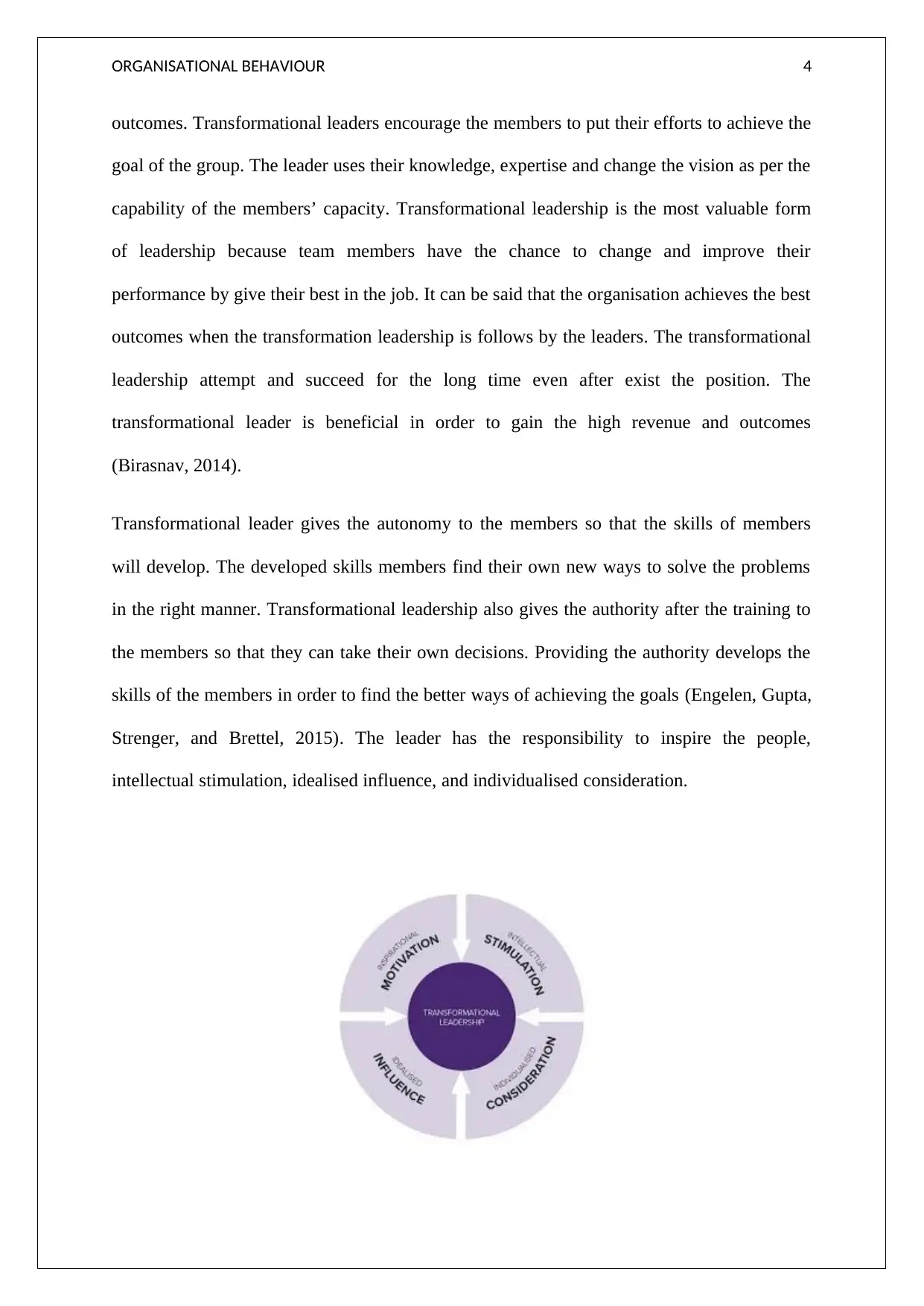
ORGANISATIONAL BEHAVIOUR 4
outcomes. Transformational leaders encourage the members to put their efforts to achieve the
goal of the group. The leader uses their knowledge, expertise and change the vision as per the
capability of the members’ capacity. Transformational leadership is the most valuable form
of leadership because team members have the chance to change and improve their
performance by give their best in the job. It can be said that the organisation achieves the best
outcomes when the transformation leadership is follows by the leaders. The transformational
leadership attempt and succeed for the long time even after exist the position. The
transformational leader is beneficial in order to gain the high revenue and outcomes
(Birasnav, 2014).
Transformational leader gives the autonomy to the members so that the skills of members
will develop. The developed skills members find their own new ways to solve the problems
in the right manner. Transformational leadership also gives the authority after the training to
the members so that they can take their own decisions. Providing the authority develops the
skills of the members in order to find the better ways of achieving the goals (Engelen, Gupta,
Strenger, and Brettel, 2015). The leader has the responsibility to inspire the people,
intellectual stimulation, idealised influence, and individualised consideration.
outcomes. Transformational leaders encourage the members to put their efforts to achieve the
goal of the group. The leader uses their knowledge, expertise and change the vision as per the
capability of the members’ capacity. Transformational leadership is the most valuable form
of leadership because team members have the chance to change and improve their
performance by give their best in the job. It can be said that the organisation achieves the best
outcomes when the transformation leadership is follows by the leaders. The transformational
leadership attempt and succeed for the long time even after exist the position. The
transformational leader is beneficial in order to gain the high revenue and outcomes
(Birasnav, 2014).
Transformational leader gives the autonomy to the members so that the skills of members
will develop. The developed skills members find their own new ways to solve the problems
in the right manner. Transformational leadership also gives the authority after the training to
the members so that they can take their own decisions. Providing the authority develops the
skills of the members in order to find the better ways of achieving the goals (Engelen, Gupta,
Strenger, and Brettel, 2015). The leader has the responsibility to inspire the people,
intellectual stimulation, idealised influence, and individualised consideration.
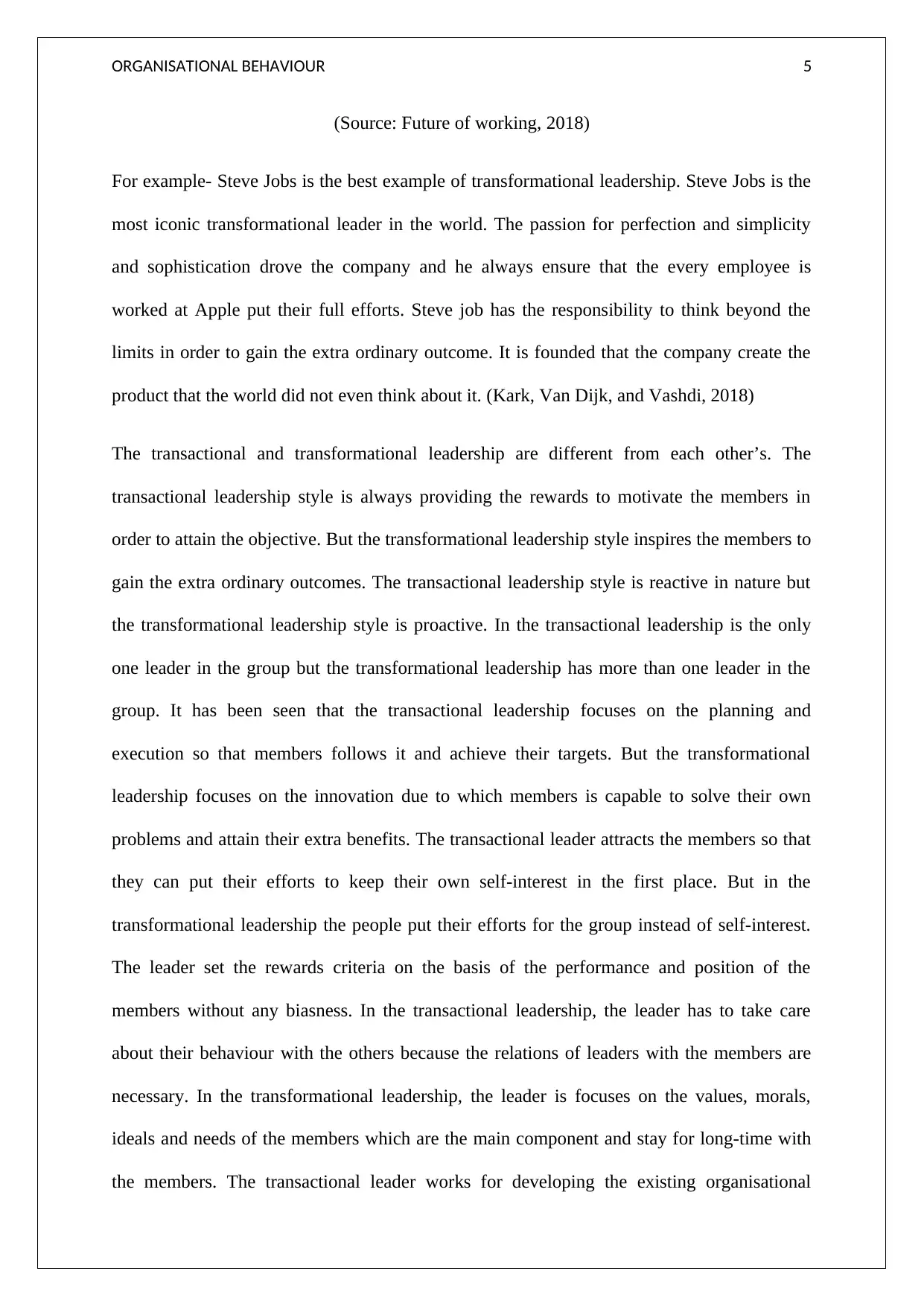
ORGANISATIONAL BEHAVIOUR 5
(Source: Future of working, 2018)
For example- Steve Jobs is the best example of transformational leadership. Steve Jobs is the
most iconic transformational leader in the world. The passion for perfection and simplicity
and sophistication drove the company and he always ensure that the every employee is
worked at Apple put their full efforts. Steve job has the responsibility to think beyond the
limits in order to gain the extra ordinary outcome. It is founded that the company create the
product that the world did not even think about it. (Kark, Van Dijk, and Vashdi, 2018)
The transactional and transformational leadership are different from each other’s. The
transactional leadership style is always providing the rewards to motivate the members in
order to attain the objective. But the transformational leadership style inspires the members to
gain the extra ordinary outcomes. The transactional leadership style is reactive in nature but
the transformational leadership style is proactive. In the transactional leadership is the only
one leader in the group but the transformational leadership has more than one leader in the
group. It has been seen that the transactional leadership focuses on the planning and
execution so that members follows it and achieve their targets. But the transformational
leadership focuses on the innovation due to which members is capable to solve their own
problems and attain their extra benefits. The transactional leader attracts the members so that
they can put their efforts to keep their own self-interest in the first place. But in the
transformational leadership the people put their efforts for the group instead of self-interest.
The leader set the rewards criteria on the basis of the performance and position of the
members without any biasness. In the transactional leadership, the leader has to take care
about their behaviour with the others because the relations of leaders with the members are
necessary. In the transformational leadership, the leader is focuses on the values, morals,
ideals and needs of the members which are the main component and stay for long-time with
the members. The transactional leader works for developing the existing organisational
(Source: Future of working, 2018)
For example- Steve Jobs is the best example of transformational leadership. Steve Jobs is the
most iconic transformational leader in the world. The passion for perfection and simplicity
and sophistication drove the company and he always ensure that the every employee is
worked at Apple put their full efforts. Steve job has the responsibility to think beyond the
limits in order to gain the extra ordinary outcome. It is founded that the company create the
product that the world did not even think about it. (Kark, Van Dijk, and Vashdi, 2018)
The transactional and transformational leadership are different from each other’s. The
transactional leadership style is always providing the rewards to motivate the members in
order to attain the objective. But the transformational leadership style inspires the members to
gain the extra ordinary outcomes. The transactional leadership style is reactive in nature but
the transformational leadership style is proactive. In the transactional leadership is the only
one leader in the group but the transformational leadership has more than one leader in the
group. It has been seen that the transactional leadership focuses on the planning and
execution so that members follows it and achieve their targets. But the transformational
leadership focuses on the innovation due to which members is capable to solve their own
problems and attain their extra benefits. The transactional leader attracts the members so that
they can put their efforts to keep their own self-interest in the first place. But in the
transformational leadership the people put their efforts for the group instead of self-interest.
The leader set the rewards criteria on the basis of the performance and position of the
members without any biasness. In the transactional leadership, the leader has to take care
about their behaviour with the others because the relations of leaders with the members are
necessary. In the transformational leadership, the leader is focuses on the values, morals,
ideals and needs of the members which are the main component and stay for long-time with
the members. The transactional leader works for developing the existing organisational
⊘ This is a preview!⊘
Do you want full access?
Subscribe today to unlock all pages.

Trusted by 1+ million students worldwide
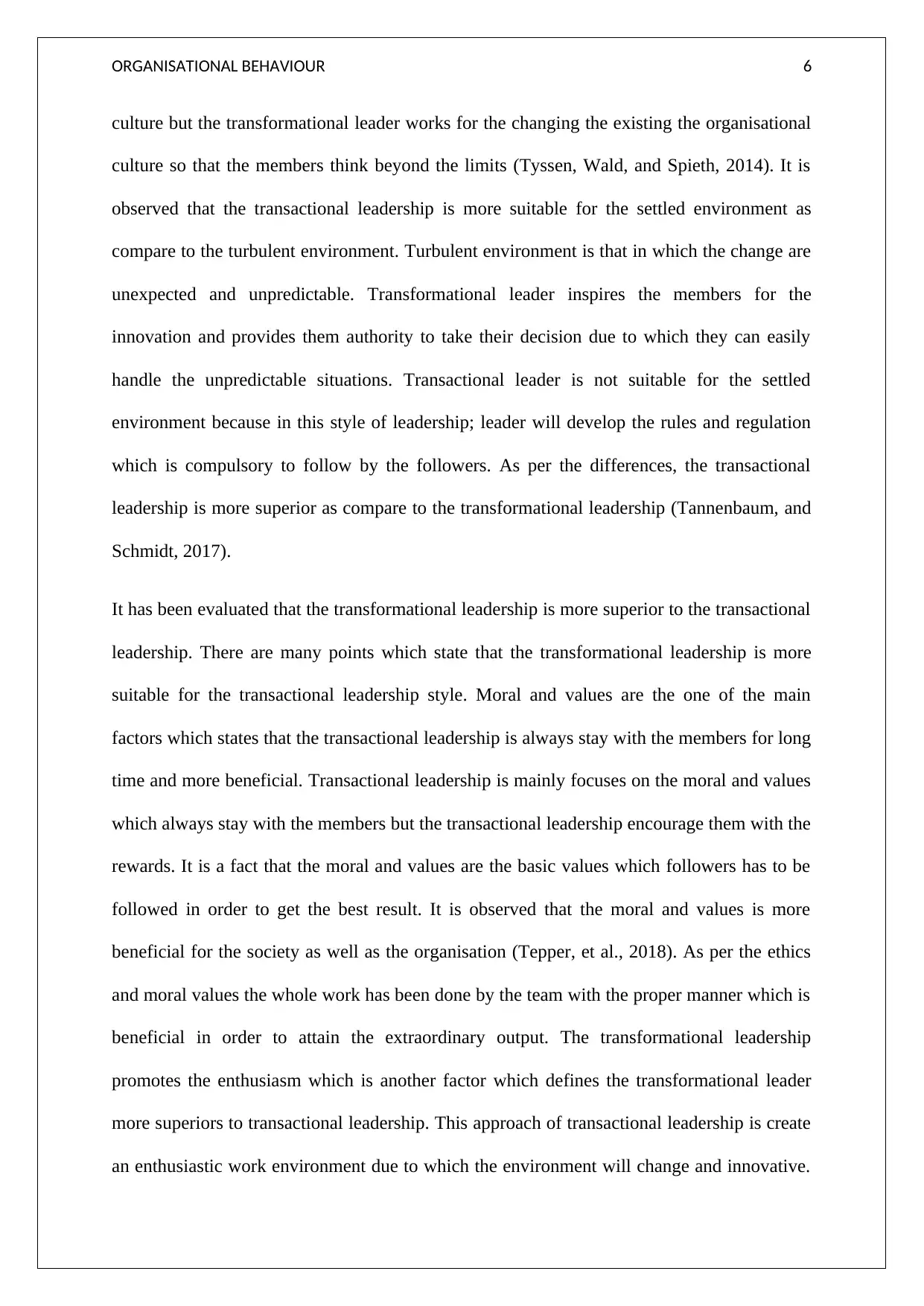
ORGANISATIONAL BEHAVIOUR 6
culture but the transformational leader works for the changing the existing the organisational
culture so that the members think beyond the limits (Tyssen, Wald, and Spieth, 2014). It is
observed that the transactional leadership is more suitable for the settled environment as
compare to the turbulent environment. Turbulent environment is that in which the change are
unexpected and unpredictable. Transformational leader inspires the members for the
innovation and provides them authority to take their decision due to which they can easily
handle the unpredictable situations. Transactional leader is not suitable for the settled
environment because in this style of leadership; leader will develop the rules and regulation
which is compulsory to follow by the followers. As per the differences, the transactional
leadership is more superior as compare to the transformational leadership (Tannenbaum, and
Schmidt, 2017).
It has been evaluated that the transformational leadership is more superior to the transactional
leadership. There are many points which state that the transformational leadership is more
suitable for the transactional leadership style. Moral and values are the one of the main
factors which states that the transactional leadership is always stay with the members for long
time and more beneficial. Transactional leadership is mainly focuses on the moral and values
which always stay with the members but the transactional leadership encourage them with the
rewards. It is a fact that the moral and values are the basic values which followers has to be
followed in order to get the best result. It is observed that the moral and values is more
beneficial for the society as well as the organisation (Tepper, et al., 2018). As per the ethics
and moral values the whole work has been done by the team with the proper manner which is
beneficial in order to attain the extraordinary output. The transformational leadership
promotes the enthusiasm which is another factor which defines the transformational leader
more superiors to transactional leadership. This approach of transactional leadership is create
an enthusiastic work environment due to which the environment will change and innovative.
culture but the transformational leader works for the changing the existing the organisational
culture so that the members think beyond the limits (Tyssen, Wald, and Spieth, 2014). It is
observed that the transactional leadership is more suitable for the settled environment as
compare to the turbulent environment. Turbulent environment is that in which the change are
unexpected and unpredictable. Transformational leader inspires the members for the
innovation and provides them authority to take their decision due to which they can easily
handle the unpredictable situations. Transactional leader is not suitable for the settled
environment because in this style of leadership; leader will develop the rules and regulation
which is compulsory to follow by the followers. As per the differences, the transactional
leadership is more superior as compare to the transformational leadership (Tannenbaum, and
Schmidt, 2017).
It has been evaluated that the transformational leadership is more superior to the transactional
leadership. There are many points which state that the transformational leadership is more
suitable for the transactional leadership style. Moral and values are the one of the main
factors which states that the transactional leadership is always stay with the members for long
time and more beneficial. Transactional leadership is mainly focuses on the moral and values
which always stay with the members but the transactional leadership encourage them with the
rewards. It is a fact that the moral and values are the basic values which followers has to be
followed in order to get the best result. It is observed that the moral and values is more
beneficial for the society as well as the organisation (Tepper, et al., 2018). As per the ethics
and moral values the whole work has been done by the team with the proper manner which is
beneficial in order to attain the extraordinary output. The transformational leadership
promotes the enthusiasm which is another factor which defines the transformational leader
more superiors to transactional leadership. This approach of transactional leadership is create
an enthusiastic work environment due to which the environment will change and innovative.
Paraphrase This Document
Need a fresh take? Get an instant paraphrase of this document with our AI Paraphraser
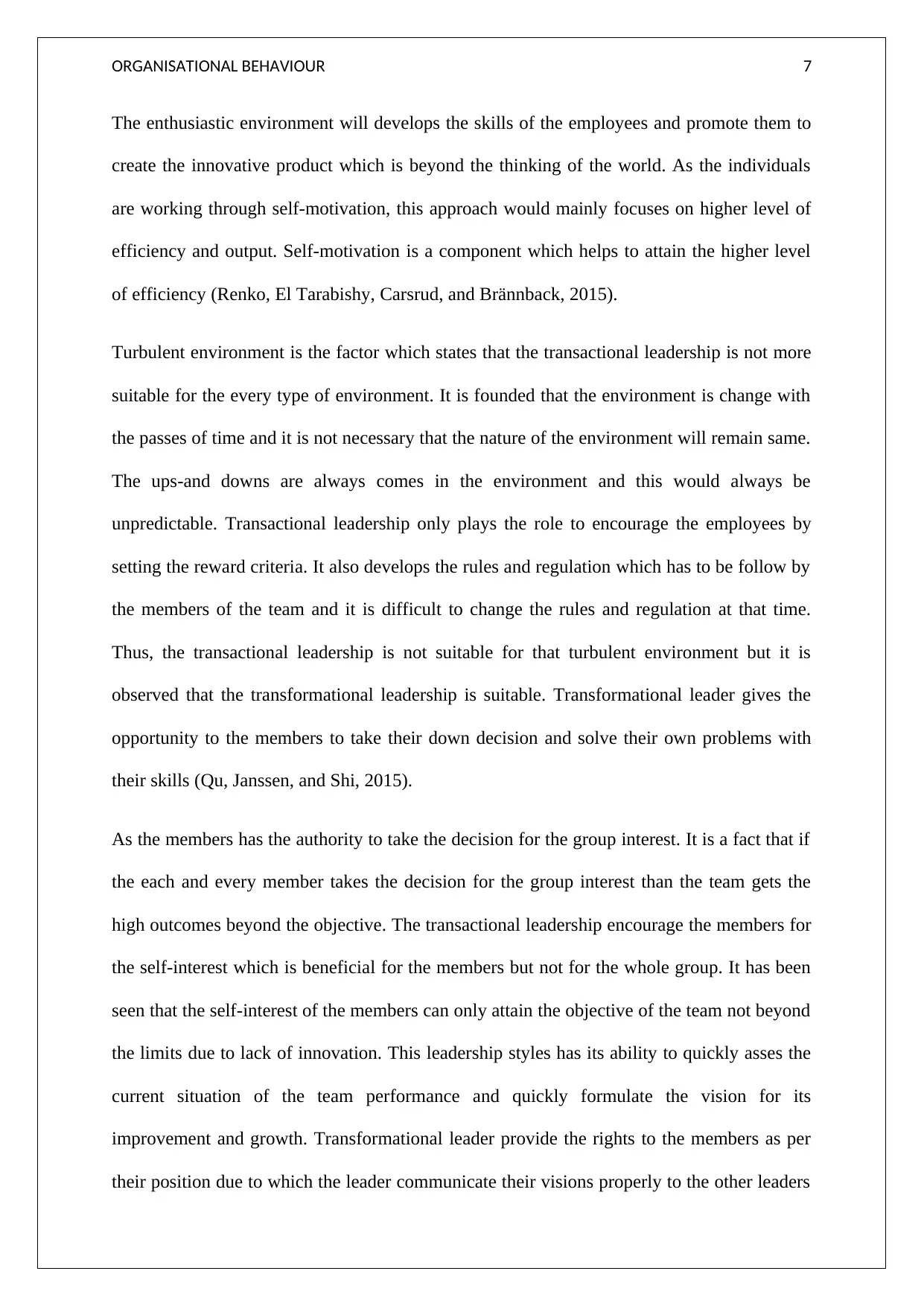
ORGANISATIONAL BEHAVIOUR 7
The enthusiastic environment will develops the skills of the employees and promote them to
create the innovative product which is beyond the thinking of the world. As the individuals
are working through self-motivation, this approach would mainly focuses on higher level of
efficiency and output. Self-motivation is a component which helps to attain the higher level
of efficiency (Renko, El Tarabishy, Carsrud, and Brännback, 2015).
Turbulent environment is the factor which states that the transactional leadership is not more
suitable for the every type of environment. It is founded that the environment is change with
the passes of time and it is not necessary that the nature of the environment will remain same.
The ups-and downs are always comes in the environment and this would always be
unpredictable. Transactional leadership only plays the role to encourage the employees by
setting the reward criteria. It also develops the rules and regulation which has to be follow by
the members of the team and it is difficult to change the rules and regulation at that time.
Thus, the transactional leadership is not suitable for that turbulent environment but it is
observed that the transformational leadership is suitable. Transformational leader gives the
opportunity to the members to take their down decision and solve their own problems with
their skills (Qu, Janssen, and Shi, 2015).
As the members has the authority to take the decision for the group interest. It is a fact that if
the each and every member takes the decision for the group interest than the team gets the
high outcomes beyond the objective. The transactional leadership encourage the members for
the self-interest which is beneficial for the members but not for the whole group. It has been
seen that the self-interest of the members can only attain the objective of the team not beyond
the limits due to lack of innovation. This leadership styles has its ability to quickly asses the
current situation of the team performance and quickly formulate the vision for its
improvement and growth. Transformational leader provide the rights to the members as per
their position due to which the leader communicate their visions properly to the other leaders
The enthusiastic environment will develops the skills of the employees and promote them to
create the innovative product which is beyond the thinking of the world. As the individuals
are working through self-motivation, this approach would mainly focuses on higher level of
efficiency and output. Self-motivation is a component which helps to attain the higher level
of efficiency (Renko, El Tarabishy, Carsrud, and Brännback, 2015).
Turbulent environment is the factor which states that the transactional leadership is not more
suitable for the every type of environment. It is founded that the environment is change with
the passes of time and it is not necessary that the nature of the environment will remain same.
The ups-and downs are always comes in the environment and this would always be
unpredictable. Transactional leadership only plays the role to encourage the employees by
setting the reward criteria. It also develops the rules and regulation which has to be follow by
the members of the team and it is difficult to change the rules and regulation at that time.
Thus, the transactional leadership is not suitable for that turbulent environment but it is
observed that the transformational leadership is suitable. Transformational leader gives the
opportunity to the members to take their down decision and solve their own problems with
their skills (Qu, Janssen, and Shi, 2015).
As the members has the authority to take the decision for the group interest. It is a fact that if
the each and every member takes the decision for the group interest than the team gets the
high outcomes beyond the objective. The transactional leadership encourage the members for
the self-interest which is beneficial for the members but not for the whole group. It has been
seen that the self-interest of the members can only attain the objective of the team not beyond
the limits due to lack of innovation. This leadership styles has its ability to quickly asses the
current situation of the team performance and quickly formulate the vision for its
improvement and growth. Transformational leader provide the rights to the members as per
their position due to which the leader communicate their visions properly to the other leaders
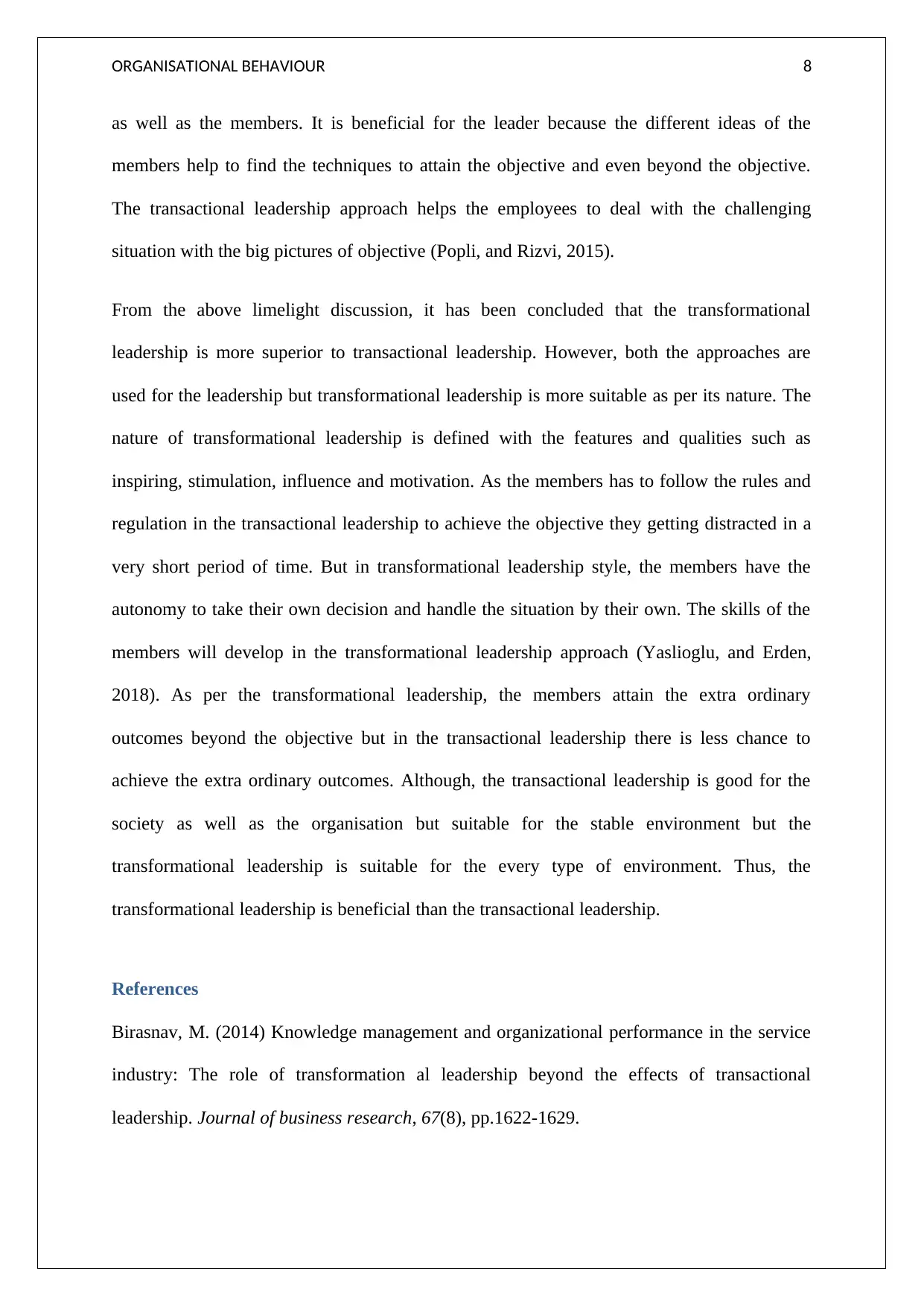
ORGANISATIONAL BEHAVIOUR 8
as well as the members. It is beneficial for the leader because the different ideas of the
members help to find the techniques to attain the objective and even beyond the objective.
The transactional leadership approach helps the employees to deal with the challenging
situation with the big pictures of objective (Popli, and Rizvi, 2015).
From the above limelight discussion, it has been concluded that the transformational
leadership is more superior to transactional leadership. However, both the approaches are
used for the leadership but transformational leadership is more suitable as per its nature. The
nature of transformational leadership is defined with the features and qualities such as
inspiring, stimulation, influence and motivation. As the members has to follow the rules and
regulation in the transactional leadership to achieve the objective they getting distracted in a
very short period of time. But in transformational leadership style, the members have the
autonomy to take their own decision and handle the situation by their own. The skills of the
members will develop in the transformational leadership approach (Yaslioglu, and Erden,
2018). As per the transformational leadership, the members attain the extra ordinary
outcomes beyond the objective but in the transactional leadership there is less chance to
achieve the extra ordinary outcomes. Although, the transactional leadership is good for the
society as well as the organisation but suitable for the stable environment but the
transformational leadership is suitable for the every type of environment. Thus, the
transformational leadership is beneficial than the transactional leadership.
References
Birasnav, M. (2014) Knowledge management and organizational performance in the service
industry: The role of transformation al leadership beyond the effects of transactional
leadership. Journal of business research, 67(8), pp.1622-1629.
as well as the members. It is beneficial for the leader because the different ideas of the
members help to find the techniques to attain the objective and even beyond the objective.
The transactional leadership approach helps the employees to deal with the challenging
situation with the big pictures of objective (Popli, and Rizvi, 2015).
From the above limelight discussion, it has been concluded that the transformational
leadership is more superior to transactional leadership. However, both the approaches are
used for the leadership but transformational leadership is more suitable as per its nature. The
nature of transformational leadership is defined with the features and qualities such as
inspiring, stimulation, influence and motivation. As the members has to follow the rules and
regulation in the transactional leadership to achieve the objective they getting distracted in a
very short period of time. But in transformational leadership style, the members have the
autonomy to take their own decision and handle the situation by their own. The skills of the
members will develop in the transformational leadership approach (Yaslioglu, and Erden,
2018). As per the transformational leadership, the members attain the extra ordinary
outcomes beyond the objective but in the transactional leadership there is less chance to
achieve the extra ordinary outcomes. Although, the transactional leadership is good for the
society as well as the organisation but suitable for the stable environment but the
transformational leadership is suitable for the every type of environment. Thus, the
transformational leadership is beneficial than the transactional leadership.
References
Birasnav, M. (2014) Knowledge management and organizational performance in the service
industry: The role of transformation al leadership beyond the effects of transactional
leadership. Journal of business research, 67(8), pp.1622-1629.
⊘ This is a preview!⊘
Do you want full access?
Subscribe today to unlock all pages.

Trusted by 1+ million students worldwide
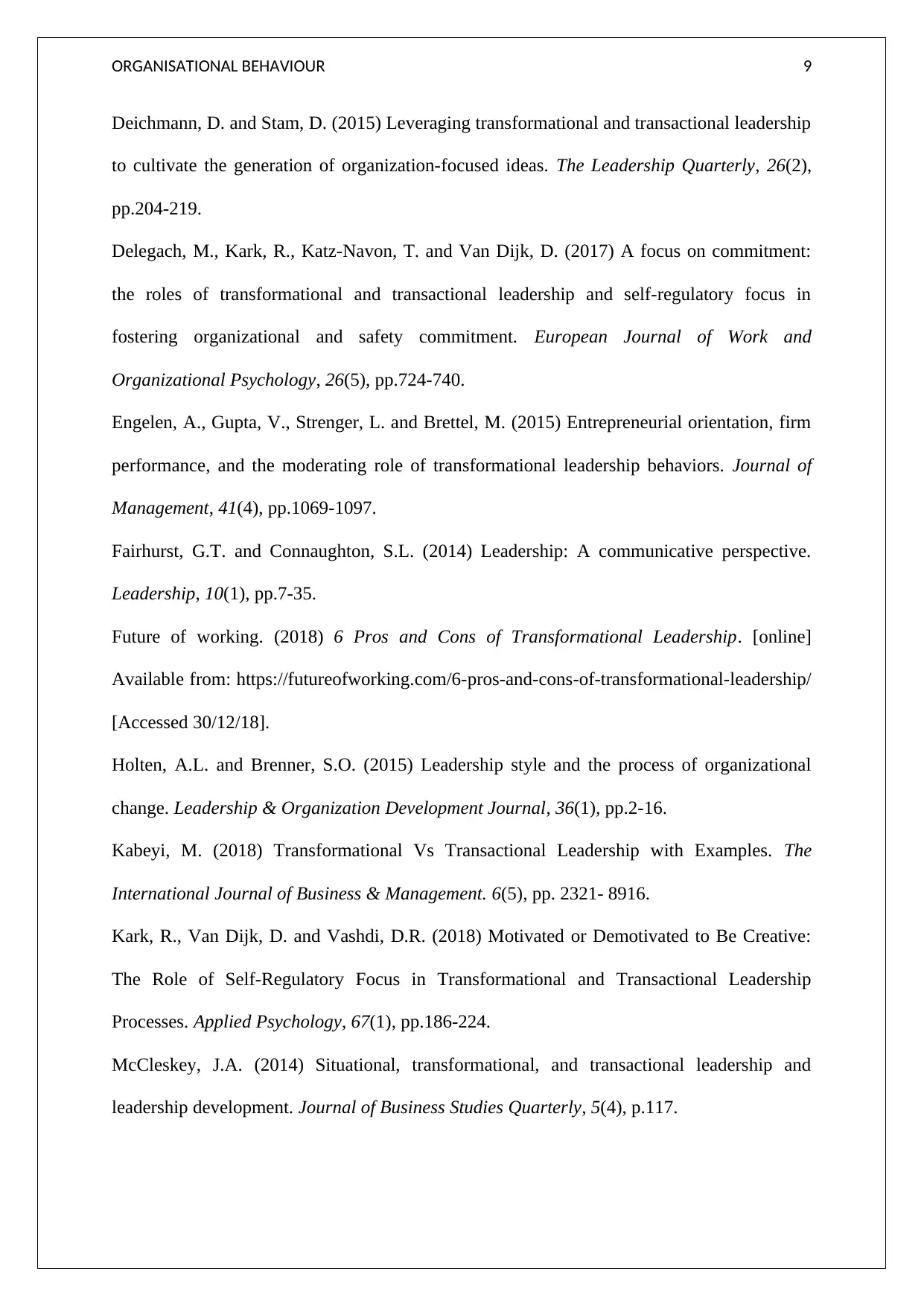
ORGANISATIONAL BEHAVIOUR 9
Deichmann, D. and Stam, D. (2015) Leveraging transformational and transactional leadership
to cultivate the generation of organization-focused ideas. The Leadership Quarterly, 26(2),
pp.204-219.
Delegach, M., Kark, R., Katz-Navon, T. and Van Dijk, D. (2017) A focus on commitment:
the roles of transformational and transactional leadership and self-regulatory focus in
fostering organizational and safety commitment. European Journal of Work and
Organizational Psychology, 26(5), pp.724-740.
Engelen, A., Gupta, V., Strenger, L. and Brettel, M. (2015) Entrepreneurial orientation, firm
performance, and the moderating role of transformational leadership behaviors. Journal of
Management, 41(4), pp.1069-1097.
Fairhurst, G.T. and Connaughton, S.L. (2014) Leadership: A communicative perspective.
Leadership, 10(1), pp.7-35.
Future of working. (2018) 6 Pros and Cons of Transformational Leadership. [online]
Available from: https://futureofworking.com/6-pros-and-cons-of-transformational-leadership/
[Accessed 30/12/18].
Holten, A.L. and Brenner, S.O. (2015) Leadership style and the process of organizational
change. Leadership & Organization Development Journal, 36(1), pp.2-16.
Kabeyi, M. (2018) Transformational Vs Transactional Leadership with Examples. The
International Journal of Business & Management. 6(5), pp. 2321- 8916.
Kark, R., Van Dijk, D. and Vashdi, D.R. (2018) Motivated or Demotivated to Be Creative:
The Role of Self‐Regulatory Focus in Transformational and Transactional Leadership
Processes. Applied Psychology, 67(1), pp.186-224.
McCleskey, J.A. (2014) Situational, transformational, and transactional leadership and
leadership development. Journal of Business Studies Quarterly, 5(4), p.117.
Deichmann, D. and Stam, D. (2015) Leveraging transformational and transactional leadership
to cultivate the generation of organization-focused ideas. The Leadership Quarterly, 26(2),
pp.204-219.
Delegach, M., Kark, R., Katz-Navon, T. and Van Dijk, D. (2017) A focus on commitment:
the roles of transformational and transactional leadership and self-regulatory focus in
fostering organizational and safety commitment. European Journal of Work and
Organizational Psychology, 26(5), pp.724-740.
Engelen, A., Gupta, V., Strenger, L. and Brettel, M. (2015) Entrepreneurial orientation, firm
performance, and the moderating role of transformational leadership behaviors. Journal of
Management, 41(4), pp.1069-1097.
Fairhurst, G.T. and Connaughton, S.L. (2014) Leadership: A communicative perspective.
Leadership, 10(1), pp.7-35.
Future of working. (2018) 6 Pros and Cons of Transformational Leadership. [online]
Available from: https://futureofworking.com/6-pros-and-cons-of-transformational-leadership/
[Accessed 30/12/18].
Holten, A.L. and Brenner, S.O. (2015) Leadership style and the process of organizational
change. Leadership & Organization Development Journal, 36(1), pp.2-16.
Kabeyi, M. (2018) Transformational Vs Transactional Leadership with Examples. The
International Journal of Business & Management. 6(5), pp. 2321- 8916.
Kark, R., Van Dijk, D. and Vashdi, D.R. (2018) Motivated or Demotivated to Be Creative:
The Role of Self‐Regulatory Focus in Transformational and Transactional Leadership
Processes. Applied Psychology, 67(1), pp.186-224.
McCleskey, J.A. (2014) Situational, transformational, and transactional leadership and
leadership development. Journal of Business Studies Quarterly, 5(4), p.117.
Paraphrase This Document
Need a fresh take? Get an instant paraphrase of this document with our AI Paraphraser
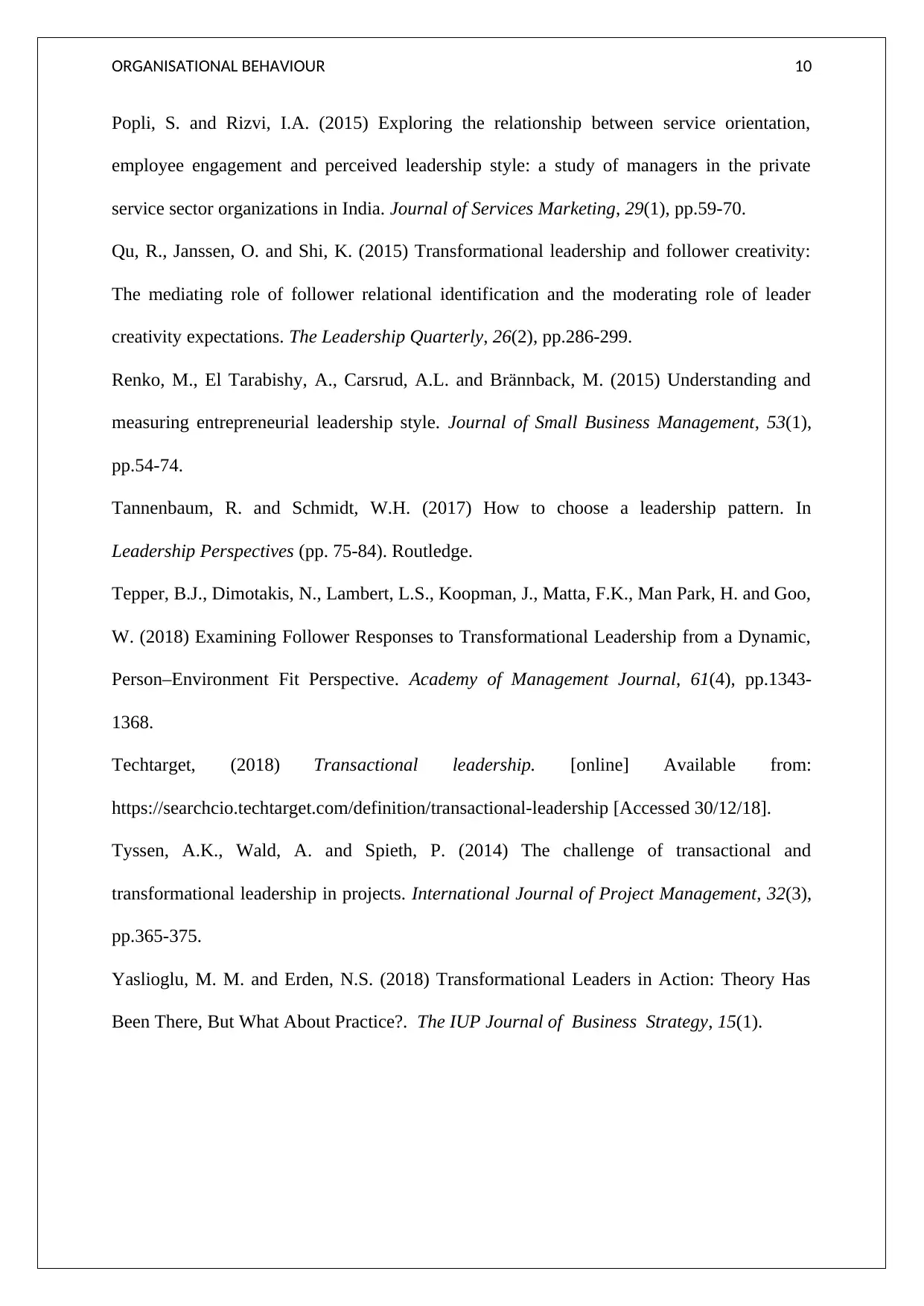
ORGANISATIONAL BEHAVIOUR 10
Popli, S. and Rizvi, I.A. (2015) Exploring the relationship between service orientation,
employee engagement and perceived leadership style: a study of managers in the private
service sector organizations in India. Journal of Services Marketing, 29(1), pp.59-70.
Qu, R., Janssen, O. and Shi, K. (2015) Transformational leadership and follower creativity:
The mediating role of follower relational identification and the moderating role of leader
creativity expectations. The Leadership Quarterly, 26(2), pp.286-299.
Renko, M., El Tarabishy, A., Carsrud, A.L. and Brännback, M. (2015) Understanding and
measuring entrepreneurial leadership style. Journal of Small Business Management, 53(1),
pp.54-74.
Tannenbaum, R. and Schmidt, W.H. (2017) How to choose a leadership pattern. In
Leadership Perspectives (pp. 75-84). Routledge.
Tepper, B.J., Dimotakis, N., Lambert, L.S., Koopman, J., Matta, F.K., Man Park, H. and Goo,
W. (2018) Examining Follower Responses to Transformational Leadership from a Dynamic,
Person–Environment Fit Perspective. Academy of Management Journal, 61(4), pp.1343-
1368.
Techtarget, (2018) Transactional leadership. [online] Available from:
https://searchcio.techtarget.com/definition/transactional-leadership [Accessed 30/12/18].
Tyssen, A.K., Wald, A. and Spieth, P. (2014) The challenge of transactional and
transformational leadership in projects. International Journal of Project Management, 32(3),
pp.365-375.
Yaslioglu, M. M. and Erden, N.S. (2018) Transformational Leaders in Action: Theory Has
Been There, But What About Practice?. The IUP Journal of Business Strategy, 15(1).
Popli, S. and Rizvi, I.A. (2015) Exploring the relationship between service orientation,
employee engagement and perceived leadership style: a study of managers in the private
service sector organizations in India. Journal of Services Marketing, 29(1), pp.59-70.
Qu, R., Janssen, O. and Shi, K. (2015) Transformational leadership and follower creativity:
The mediating role of follower relational identification and the moderating role of leader
creativity expectations. The Leadership Quarterly, 26(2), pp.286-299.
Renko, M., El Tarabishy, A., Carsrud, A.L. and Brännback, M. (2015) Understanding and
measuring entrepreneurial leadership style. Journal of Small Business Management, 53(1),
pp.54-74.
Tannenbaum, R. and Schmidt, W.H. (2017) How to choose a leadership pattern. In
Leadership Perspectives (pp. 75-84). Routledge.
Tepper, B.J., Dimotakis, N., Lambert, L.S., Koopman, J., Matta, F.K., Man Park, H. and Goo,
W. (2018) Examining Follower Responses to Transformational Leadership from a Dynamic,
Person–Environment Fit Perspective. Academy of Management Journal, 61(4), pp.1343-
1368.
Techtarget, (2018) Transactional leadership. [online] Available from:
https://searchcio.techtarget.com/definition/transactional-leadership [Accessed 30/12/18].
Tyssen, A.K., Wald, A. and Spieth, P. (2014) The challenge of transactional and
transformational leadership in projects. International Journal of Project Management, 32(3),
pp.365-375.
Yaslioglu, M. M. and Erden, N.S. (2018) Transformational Leaders in Action: Theory Has
Been There, But What About Practice?. The IUP Journal of Business Strategy, 15(1).
1 out of 11
Related Documents
Your All-in-One AI-Powered Toolkit for Academic Success.
+13062052269
info@desklib.com
Available 24*7 on WhatsApp / Email
![[object Object]](/_next/static/media/star-bottom.7253800d.svg)
Unlock your academic potential
Copyright © 2020–2025 A2Z Services. All Rights Reserved. Developed and managed by ZUCOL.





